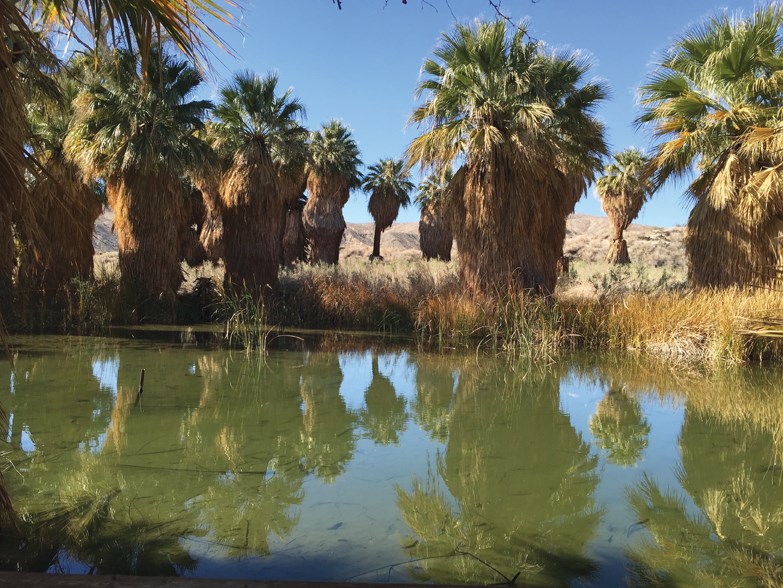The San Andreas Fault stretches over 1,130 kilometres from the border with Mexico to just north of San Francisco where it plunges into the Pacific Ocean. The Thousand Palms Oasis Preserve is 360 hectares (880 acres) collectively known as the Coachella Valley Preserve and located on the Mission Creek trace of the fault between the towns of Desert Hot Springs and Indio, California. It is one of the largest groves of desert fan palms in California.
Springs arising along the fault are the water source for these trees which reach a height of up to 20 metres with leaves over two metres wide. Their dead fronds form a skirt providing shelter for many species of desert animals including black widow spiders, snakes, lizards and rodents. The small fruits produced by the trees were once an important traditional food source for the Cahuilla people.
Once considered an infinite wasteland, deserts are now recognized for the abundance and diversity of the life they support. In this desert valley alone there are over 500 species of native plants, 200 species of birds and over 30 species of mammals, including cottontails, jackrabbits and gray fox. This rare desert oasis is also home to cottonwood trees and willow tucked in among the palms.
There are over 40 km of hiking trails, and I set off to experience this desert preserve offering spectacular views, wide canyons and deep silence.
At this time of year, the spring wildflower are not yet in bloom, but I am beckoned by the loud call of the cactus wren as I make my way across the seeps and ponds on wooden walkways hidden by great canopies, the smell of dank, decaying fronds permeating the humid atmosphere.
I am following the McCallum Trail into Palm Canyon, which will take me on a three-km adventure across an earthquake fault zone, and though a desert wash, ending at the McCallum Oasis.
On leaving the forest, the desert wash is in stark contrast but many plants spring up from the loose sandy floor – arrowweed, golden bush, inkweed and desert smoke tree. The heat is rising and I spy a spiny lizard just off the trail ahead, as it seeks refuge.
Following the well-signed trail, I make my way back towards McCallum Pond. I pass Moon Country Trail and walk about 15 minutes across the dunes, spying mesquite hammocks growing upwards in the sand before arriving at this beautiful, almost turquoise pond.
A sparrow perches on a branch reaching up out of the pond, occasionally taking off and swooping low to dip its wings in the cool water. The atmosphere is completely still; not even a desert breeze reaches my skin as I peer into the clear water.
Apparently the pond is formed by a natural earthquake seep, water seeping up along one of the several faults in this zone. It is home to the red swamp crayfish as well as native tree frogs, toads and the endangered desert pupfish.
I can only stare at the lone sparrow resting on the branch in the middle of the pond – such a perfect place to sit and rest and contemplate the desert wonders in this tranquil setting.



